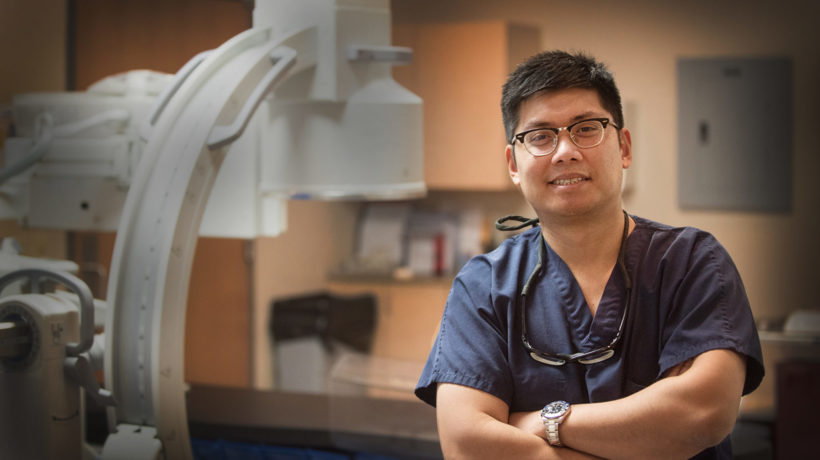Interventional Radiologists are at the Cutting Edge of Life-Saving Medical Care

Things were looking hopeless for one cancer patient also suffering from multiple health issues. In his mid-70’s, the man had diabetes, constricted blood vessels, a bad heart and cirrhosis of the liver. When it was discovered that he also had a liver tumor, no surgeon wanted to touch him.
We talked about this case at the Tumor Board and the surgeons said, ‘No way. This guy is too sick and has too many things going on. It’s too risky to operate,’” says Dr. Keith Chan, a diagnostic and interventional radiologist at TRA Medical Imaging. “The oncologists said, ‘He won’t survive the chemotherapy.’ Then he came to us.”
Contrary to the popular image of radiologists as highly trained people who take medical images and interpret them, Chan and his colleagues perform multiple complex procedures every week, many of which didn’t even exist a decade ago. “We do a lot of specialized procedures,” Chan says. “This is a constantly evolving field and some of the biggest changes are in the field of interventional oncology.”
Beyond diagnosis, interventional radiology (IR) is now being used to actively treat cancer. “We have developed technologies where we can potentially control and stop cancer from growing,” says Chan. “In some cases, we can eliminate tumors entirely and allow people to be cancer free.”
Y90 radioembolization is one example of such a procedure. Instead of chemotherapy, which affects the whole body and has numerous side-effects, Chan’s procedure involves injecting tiny glass or resin beads filled with the radioactive isotope yttrium (Y90) into the microscopic blood vessels that feed a tumor. “Rather than expose the whole liver to radiation, we can target just a tiny fraction of the liver where the tumor is with a focused lethal dose of radiation,” Chan explains.
When the patient with liver cancer was referred to him, Chan called him. “I said, ‘I’ve heard about your case and I think I may have an option for you,’” he recalls. “He told me, ‘I’ve been living with cancer for more than a year now and they tell me I might have a little more than a year left. I’m willing to give it a shot.’”
The man and his wife flew out from Idaho and within the week he’d undergone the Y90 procedure. After a waiting period to give the treatment enough time to take hold, he came in 2 months later for a repeat scan. “I will never forget walking into that clinic office and seeing him and his wife,” says Chan. “I told them, ‘You are now cancer free.’ The two of them just started crying and he said, ‘I don’t know what to do with the time that’s been given to me now.’ He still comes into the clinic every three or four months and there is no trace of any remaining cancer.”
Chan and his colleagues perform the Y90 procedure weekly for different patients. Many have liver cancer, but some have cancer of the colon that has spread to the liver. Many of the patients they treat are those who have failed at other forms of treatment, including chemotherapy.
Interventional Radiologists also help with benign diseases like prostate enlargement and uterine fibroids which, while not life-threatening, can certainly have a significant impact on quality of life. “I remember female patients with such heavy menstrual bleeding that they couldn’t leave their house,” says Chan. IR procedures can shrink the prostate and fibroids, allowing men to urinate normally and women to have a more bearable menstrual cycle. Until recently, the only recommended cure for these female patients when oral contraceptives didn’t work was surgery. “It’s like giving somebody a new life,” says Chan.
IR is usually an outpatient procedure that is less invasive and has a faster recovery time than traditional surgery. With Y90, the doctors enter the body through a tiny pinhole in the femoral artery of the groin. “If you had a traditional liver resection you would be left with a eight to ten-inch scar and spend one to two weeks in the hospital,” says Chan. “Here it takes a couple of hours, you end up with a two-millimeter hole in your groin and a Band-aid, and you’re literally home that night.”
Although IR is becoming more well-known, many physicians outside of the university setting are still unaware that these technologies exist. Chan suggests that patients ask their doctors about IR options, particularly in cases where other treatments have failed, or they are experiencing significant pain. “We also can do a lot of therapy for pain,” he says. “The patient may have a problem somewhere in their body that cannot be remedied by traditional medicines or surgeries.”
Mainly, he says, learn more about what’s possible. Chan recommends the Amazon Prime series Without a Scalpel, which features examples of cases treated with IR. “We can really improve people’s lives,” he says, “but many of them have never heard of what we can do.”
July 31, 2018
Heidi Smith
http://www.thurstontalk.com/2018/07/31/interventional-radiologists-are-at-the-cutting-edge-of-life-saving-medical-care/
